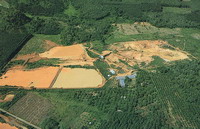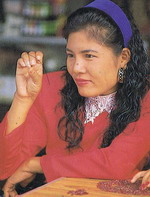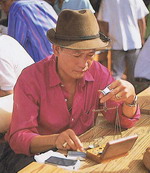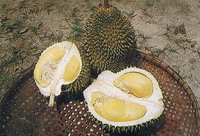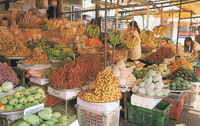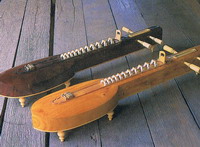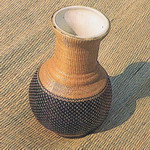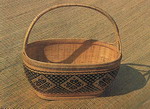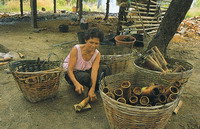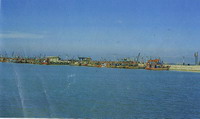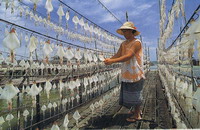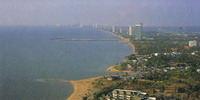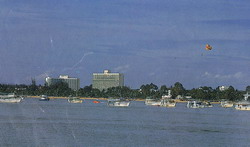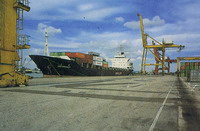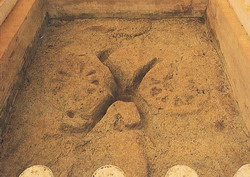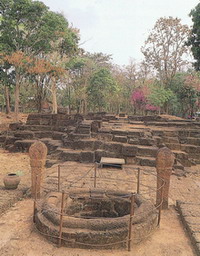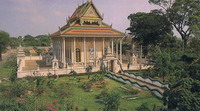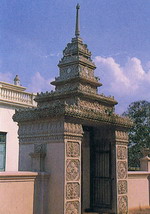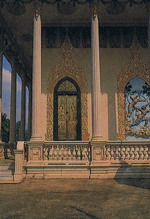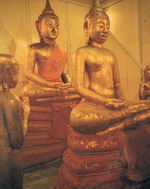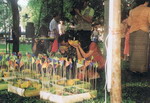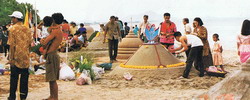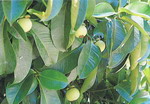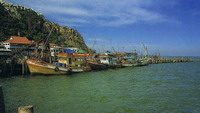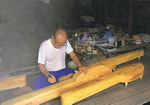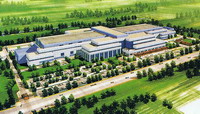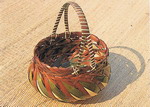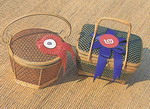
Search
 Custom Search
Custom Search
Cultural Landscape of the Eastern Region of Thailand Geographical features
To the north, the eastern region is bordered by the San Kamphaeng Mountain Range and part of the Phanom Dongrak Mountain Range, which separates the eastern and northeastern regions. To the east, the Banthat Mountain Range forms a natural boundary between the eastern region and Cambodia. To the south and southwest lies the Gulf of Thailand and to the northwest is an expanse of flat terrain connected to the central plain. The eastern region is composed of seven provinces, namely Prachin Buri, Chachoengsao, Chon Buri, Rayong, Chanthaburi, Trat and Sra Kaew, covering a combined area of 34,381 square kilometers or about 6.70 of the total area of the country. Physical Features
The physical features of the eastern region consist of three main parts, mountain ranges, a river basin surrounded by undulation plains, and a coastal plain. The Mountain Ranges in the central part of the eastern region, there are two mountain ranges one stretching in a northwesterly direction, the other in a southeasterly direction, namely, the Chanthaburi Mountain Range and the Banthat Mountain Range. The Chanthaburi Mountain Range, which starts from Muang district in Chon Buri and ends up in Khlung district in Chanthaburi, is 281 kilometers long. The main peak of this range is Soi Dao Tai mountain. The Chanthaburi Mountain Range separates the flow of water into two directions, one flowing north to Prachinburi - Bangpakong River, the other flowing south to a rather short river which ends up in the Gulf of Thailand. Starting from Bor Rai district in Trat province to end up at Laem Sarapatphit in Khlong Yai district, the Banthat Mountain Range, on the other hand, is located to the east of the Chanthaburi Mountain Range, and forms a north-south boundary line separating Thailand from Cambodia.
The River Basin and Undulating Plains. The largest river basin in the eastern region is the Prachin Buri - Bangpakong river basin. Some distance away to the north of the river basin towards the Sankamphaeng Mountain Range, and to the south, towards the Chanthaburi Mountain Range, there are undulating plains, the rise and fall of the terrain caused by the erosion of rocks along the sides of the hills. There are a few hills of about 200 meters high scattered throughout this ares. The coastline of the eastern region is about 515 kilometers in length, with virtually every province flanked by the sea, the sole exception being Prachinburi.
The Chachoengsao coastline, which starts to the west of the mouth of the Bangpakong River and stretches to the border of Chon Buri province, consists of muddy beachis while the gently curving coastline of Chon Buri province forms several inlets, separated from another by small promontories. The Chanthaburi coastline is similar to that in Rayong province, that is, it consists mostly of short stretches of muddy or muddy and sandy beaches. In the past, most part of the coastline used to be covered by mangrove forests; nowadays, however, vast tracts have been developed into shrimp and cockle farms, for example, areas in Kung Kabaen inlet, Khok Nok inlet, and from the mouth of Chanthaburi River to the mouth of the Waelu River.
In Trat province, one of the coastline is made of muddy or muddy and sandy beaches, while the other half is composed of narrow sandy beaches. There are approximately 144 islands lying off the coast of the easter region, of which 50 belong to Trat province and 43 to Chon Buri. While most of the islands in Chon Buri are small, Koh Khram, Koh Sichang, Koh Laan, and Koh Phai are fairy large. There are 12 islands off the coast of Rayong province, the biggest and the most famous being Koh Samet, which is reputed for a particularly beautiful beach with fine while sand called "Sai Kaew" in the northern part of the island. In addition, to the east, there is a vast coral reef, making this island one of the most popular tourist spots in Rayong.
In Trat province, there are several large islands, the biggest of which is Koh Chaang, and the second biggest is Koh Koot. Physical Features and Natural Resources : with their influences on the occupations of people in the eastern region The eastern region is a fertile area boasting all kinds of forests, including tropical evergreen forests with many varieties of trees, Siamese sal forests, and mangrove forests. At present, certain sections of these forests have been preserved and designated as the site for a wildlife sanctuary at Khao Khieo.
There are also many kinds of rocks in this region. Igneous rocks, for example, granite, and metamorphic rocks, for example gneiss and schist, are widespread in the western past of the region, i.e. in Chon Buri, Rayong and Chanthaburi. The highest peaks of the Chanthaburi Mountain Range, Soi Dao Tai and Soi Dao Nue, also consist of granite, which explains why one of the notable industries in Chon Buri is the productions of mortars, an indispensible utensil in most Thai kitchens. In addition, the fine white sand on Samet Island is used as one of the raw materials in the production of glass industry. In the eastern part of the region, however, in Prachin Buri and Trat, most of the rocks are composed of sandstone and limestone, although in certain areas igneous rocks in the form of granite and basalt can also be found. Basalt, which is the source of colored gemstones, including ruby, topaz, and sapphire, occurs in a small are in Khlung district and Pong Namron district in Chanthaburi, and in Bor Rai district in Trat.
Since the natural gas from the Gulf of Thailand is piped ashore at Rayong province, the eastern region has become a center for the generation of electricity from natural gas as well as a center for the petrochemical industry (at Mabtaphut) and petroleum production. The region has also been marked for development in line with the strategic changes that have been planned, regrading economic structure of the country for the purpose of transforming Thailand into a newly industrialized economy. Chon Buri, Rayong and Chachoengsao, in particular, have been developed as industrial sites for export-oriented industries as well as for those industries which manufacture products for domestic consumption, thereby doing away with the need to import such goods.Several indulstrial estates and deep-sea ports have been constructed in this region in accordance with the Eastern Seaboard Development Project.
People in the eastern region earn their living by growing several types of crops. For example, these are sugar cane plantations, cassava plantations, lo-tin plantations, pineapple orchards, and rice paddies. There are also rice mills and shipyards where fishing boats of different sizes are made. Other industries in which people in this region are engaged include fishery, while sugar industry, fish sauce industry and distilleries usually belonging to Thais of Chinese descent.
As there is an abundance of bamboo in the eastern region, some local people earn their living by making wickerwork, or roasting glutinous rice in bamboo segments, and as there are a lot of reeds growing in Chanthaburi, a cottage industry has sprung up in this province involving the weaving of reed mats. In addition, there are many kinds of trees, the wood from which is often made into musical instruments; for example, the cha-khey (a stringed musical instrument sometimes called the Thai zither) is made from the wood of the jack fruit tree; the so-duong (a high-pitched stringed instrument) is made from the wood of the ching-chum tree (a kind of rose wood) and the xylophone is made from the wood of the ching-chum or from phai-bong (a kind of bamboo). The Community
The eastern region is an area which has been inhabited by Man since pre-historic times. For example, Koke Phanomdi in Phanat Nikhom district, Chon Buri, as well as nearby areas in Koke Raga, and Phan Thong district, Chon Buri are sites of pre-historic communities, dating back around 5,000 - 3,250 years. In the past, the eastern region was located along main trading and communications routes, which linked several district kingdoms, a function it has still fulfilled to this day. Consequently, there are people of mixed race living in this region. Apart from Thais, there are descendants of the Khmer, Chinese, Laotians and Vietnameses, as well as Pakistani Muslims, not to mention members of certain minority hilltribes including the Chaung and Karen.
People of different races who settled in the eastern region brought with them their beliefs, their religion, (including Mahayana Buddhism), their values, wisdom and technology which they used in their occupation. For example, the Chinese have brought with them their language, beliefs, customs and traditions, together with several technologies, including ship-building, boat-building, poultry and pig raising, fishing, the planting of sugar cane and cassava, the milling of rice, the fish sauce industry, and the sugar industry, as well as introducing methods for making several kinds of Chinese noodles.
The Laotian people who arrived in this region in the reign of King Rama III brought with them their language, beliefs, customs and traditions and technologies, for example, cloth-weaving, the weaving of wickerware, and the manufacture of a particular kind of firework : the giant sky recket. Cultural Components
As this region is a 'melting pot' of people of mixed race and different religious beliefs, it forms a kind of patchwork quilt, rich in terns of cultural diversity. The four basic necessities, including housing, clothing, food and medicine represent tangible expression of the various cultures of the people who settled in this region. Housing In this region, house are made from materials that are locally available, in according with the economic status and cultural background of the owners. Thai people or the Thais of Laotains, Mon, or Khmer descent like to build single-story house raised up on stilts, leaving a space under the house. The roof is usually covered with palm leaves, other kinds of leaves, corrugated iron, or tiles. Such houses have a broad outdoor living area adjacent to the house, like houses in the central region. The Chinese, on the other hand, usually build two-story houses, with the first floor at ground level, and a second floor called "low-teng". Chinese traders like to have a two-story house either of wood or cement, containing a long narrow hallway. Thai Muslims usually build a house with a simple roof without gables (pan-ya house).
Clothing People in the eastern region dress simply, in loose-fitting clothes. Women usually wear a kind of skirt similar to a sarong and a simple low-cut or round-necked top. Men usually wear Chinese-styles trousers made from cotton or synthetic material and a loose-fitting top. In the past, weaving used to be a local industry in certain areas of the region. For example, Ang-Sila district in Chon Buri was renowned for the weaving of cotton cloth and brocade while the people of Prachin Buri bred silk-worms and this gave rise to a local silk weaving industry just like in the northeastern region. |
Click Here!
|
Food As the people in the eastern region are of mixed race, religion and culture, the food also varies according to the community in which a person livers and the occupation be pursues. Thais of Chinese origin, most of whom live either in areas or on the coast, like to eat mild, fatty food with a high protein content usually provided by meat. They also eat protein in the form of sea food, poultry, and pork, all of which are produced in this area. Most of the ingredients they use are fresh as they do not eat pickled or preserved food. However, from the middle of September to the beginning of October, they will eat food cooked from vegetable only, and abstain from eating any kind of meat, except oysters. People who live to inland areas and in the upper part of the region, on the other hand, like to eat dishes made from vegetables and fresh-water fish, whether fresh, dry or pickled, in the same way that most Thais, or Thais of Laotian arigins who live in the central and northeastern regions of Thailand do. Regarding Thai Muslims, Their food is the same as that of Mulslims in other regions of Thailand. In addition, Thais of Vietnamese descent have their own typical dishes, namely, 'nam nuang', Vietnamese sausages, etc., just like their counterparts in other regions, with rice as their favorite staple of which there is an abundant supply in the area (opposed to the glutinous or 'sticky' rice favoured by people in the northeast). A specialty of the region is a curry made from pork and Chamuang leaves, usually served on festive occasions.
Health Care Long befor hospitals were established and the practice of modern medicine was introduced. Thai and Chinese traditional medicine provided treatment for the people in the eastern region. About 90 percent of the medicine used by practitioners of traditional medicine, whether Thai, Lao, Khmer, or Chinese, were derived from herbs and plants. Very few ingredients in the medicine were obtained from other sources or from animals. Nowadays, both monks and laymen practise traditional medicine and schools of traditional medicine have been estableshed in some provinces, (For example, in Wat Yai Intraram in Chon Buri).
The non-material aspects of the culture include social institutions, the family, government, education and religion, as well as ritual and tradition, and beliefs and values. Religious and Beliefs People in the eastern region are adherents of different faiths including Buddhism (Mahayana and Theravada), Islam and Christianity while members of minority groups and people different occupations subscribe to a variety of different beliefs. For example, the fishermen have various beliefs regarding the equipment used on board their boats, and objects and entities that they consider sacred. They believe that each boat has a guardian spirit, in addition to believing in the ability of amulets to protect them. Also, like fishermen everywhere, they believe in the power of certain natural phenomena. Consequently, several customs and traditions related to these beliefs have evolved, for example the custom of paying respects to the guardian spirit of a boat, of making merit to assure good fortune of a boat, of offering rice to the boat's guardian spirit, of blessing a new boat before it is launched, of blessing the nets staked out in their traditional fishing grounds, as well as holding a special festivities to make offerings to the guardian deities.
Farmers too have their own individual beliefs; for example, believe that the Goddess of Rice and other beings and objects they hold to be sacred are capable of producing the right amount of rainfall for them at the right time of the year. As a result, many customs and traditions relating to this belief have sprung up, for example, a ceremony welcoming the Goddess of Rice, a ceremony asking the sky for rain by walking in a procession carrying cats, a ceremony asking for rain by carrying a giant sky rocket, a kind of firework, in procession to the place where they are set off, and the tradition of buffalo racing.
Traditions in the eastern region can be divided into four types, namely traditions relating to daily life, traditions relating to specific belief, traditions relating to religion, and traditions relating to games and enertainment. There are a number of interesting traditions that are an integral part of daily life, including a ceremony marking the birth of a child, a ceremony at which a child's top knot is shaved off (to mark the end of childhood), a tradition involving a young man entering into the monkhood, cremation rites, a local tradition of beating the gong to proclaim the death of the community, etc. There are also a number of traditions reflecting the beliefs of people in the eastern region, for example, a tradition of making merit for the sky rocket used in the ceremony asking for rain, a tradition fo invoking the spirit of rice in the paddy fields has started develop ears, a tradition of welcoming the Goddess of Rice, a tradition of floating the Krathong in the twelfth lunar month, etc.
The region is rich in traditions relating to Buddhism, including the hurting of water during Songkran, the building of sand chedies on Songkran Day, the dredging of canals and waterways during Songkran (Songkran Nam Lai), the pesenting of food to Buddhist monks by the drawing of lots, the gathering together to listen to a sermon about one of the last earthly incarnations of Lord Buddha, the presenting of special rebes for bathing to Buddhist monks, "Saat Thai," or a religious festival that is held during the tenth lunar month, the offering of food to monks by placing special foo (Khao Tom Hang) in the bowls of those monks who come to receive food on the first morning after Buddhist lent. Traditions observed by people in the eastern region concerning plays and entertainment include simple games for children, for example, Mon Son Phaa (a game in which a handkerchief is hidden behind a person taking part in the game) and Mai Hung (a game in which a stick is hurled) and games played by young people on festive occasions for example, Sabaa, which offers an opportunity for young boys and girls to meet.
Since the traditional way of life is in danger of disapearing, a concerted effort has been launched to promote - and in some case revive it. Tham Boon Kor Phra Sai Nam Lai Tradition This particular tradition also known as Wan Lai, is observred by people in the seaside communities of Saen Sook and Khor Si Chang subdistricts of Chon Buri, the majority of the population are fishermen whose deep attachment to the sea has given rise to a number of beliefs. During the Songkran Festival, people in these communities make merit by offering food to the m onks, bath a Buddha image with fragrant water, pour water over the hands of their superiors and ask for their blessing, fashion a Buddha image out of sand, and head for the beach where they really get into the spirit of Songkrant.
In the past, this tradition was observed whenever people together to dredge the sand from the bottom of ditches, canals and ponds to make the water flow more easily. The sand was then taken to a temple where it was used to build a chedi. This tradition is particularly beneficial since the dredging keep the canals, ditches and ponds from being too shallow and the sand that is dredged up is used for buiding and developing the temple. Kong Khao Buang Suang Tradigion
This tradition involves inviting of the spirits of the dead to come and possess, a tradition handed down from generation to generation and practised by people in Chon Buri, Muang District, as well as Sriraja, Panatnikhom, Ban Bueng, Banglamung districts and Khor Chang sub-district. During the ceremony, four days after Songkran Day, people provide offerings to the spirits and souls of the dead so that the latter will protect people from harm and danger, ghereby enabling them to live peaceful and happy lives. Buffalo Racing Tradition Buffalo racing, a tradition of Chon Buri, usually takes place on the fourteenth day of the waxing moon in the eleventh month of the lunar calendar, towards the end of the rainy season and the beginning of the cold season. The crops in the fields are bearing flowers and fruit. The owners of the buffalos are grateful for the animals for having worked hard for them for a long time, and want to repay them for their kindness. The owners adorn their buffalos with beautiful ornaments and take them to town to take part in a race. They believe that running keeps the buffalos in good shape and help them recover from illness.
The buffalo raci in Chon Buri has recently been impoved and made more up-to-date in line with the times. At the race, there is also a buffalo health contest, the purpose of which is to conserve the local breed of buffalo. Socio-Cultural Change Ever since the advent of social and economic development, the region has witnessed the rapid development of the means of communication, thereby joining different parts of the region together and linking it sith other parts of the country as well as to other counties overseas. This, in turn, has led to a change in the career structure and the way of life of the people. In the past, most people in the region earned their living by fishing or some sort of jobs related to fishery. However, when they have to change their occupations due to the limitation of fishing grounds and the scarcity of fish, they turn to aquaculture, breeding fish, shrimps and shellfish, etc. As a result, the mangrove forest has been opened up to make way for shrimp farms and fish farms, thus causing the rapid destruction of the area of what was once lush mangrove forest, a valuable natural resource as well as a natural habitat for young aquatic creatures. As these animals have lost the place where they can nurture the young, aquatic life, another important natural resource which could once be found in great abundance in this area has rapidly decreased.
During the past twent years, a large number of factories have sprung up in this region, including sugar factories, tapioca factories, food processing, chemical, textile, animal feed, ply-wood, construction material, petroleum, and car assembly factories. Currently, there are to fewer than 3,000 such factories, which absorb a large part of the local labor force, most of whom used to be farmers and fishermen. When these people changed jobs and began working in factories, their way of life also began to change. In the past, the relationship between members of society was very close. As the area has become increasingly urbanized, however, people of different cultures from different areas have migrated to the region, resulting in a looser relationship among members of the communities. As a result, people have difficulty in adjusting, thereby giving in to vrious problems including maltreatment, labor being taken advantage of, as well as social problems, such as the abuse of narcotics and crime. As industrial development has been widespread, farmers sold their land to industrial entrepreneurs who used the land to establish factories, hotels and resorts bringing great wealth to the land owners and prompting them to adopt new values. Consequently, they have developed a taste of modernity, luxury, convenience and comfort.
|
||||||||||||||||||||||||||||||||||||||||||||||||||||||||||||||||||

